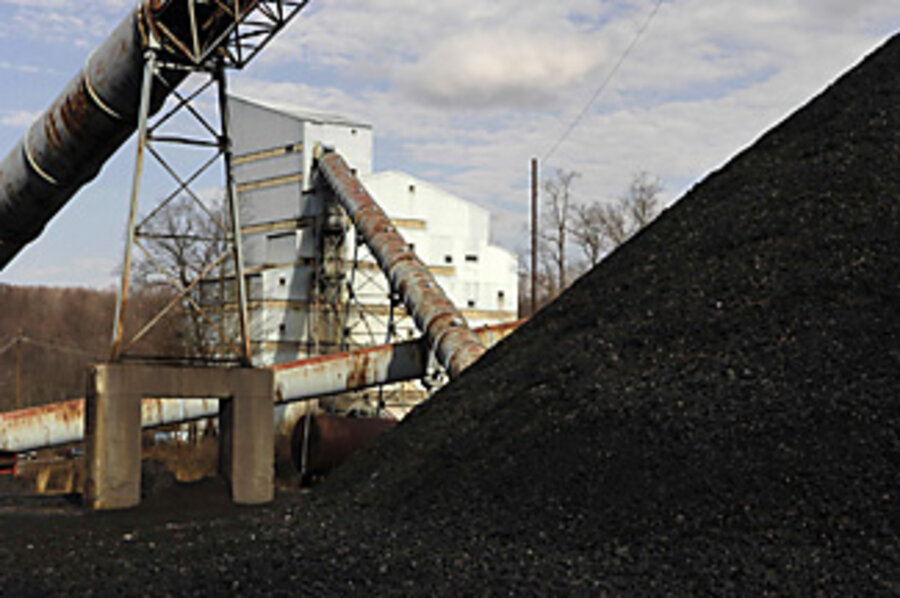How the mountains of Appalachia disappear
For a practice that has drastically changed the topography of Appalachia, most Americans – even those who consider themselves environmentalists – know surprisingly little about mountaintop mining.
The technique, in which the top of a mountain is literally blasted off and dumped into the surrounding valleys to unearth the valuable coal underneath, has leveled mountain peaks, destroyed more than 1.5 million acres of hardwood forest, and buried more than 700 miles of streams.
The reason this practice remains unchecked has a lot to do with where it takes place. In his new book, Coal River,Michael Shnayerson aims to draw attention to this environmental battle raging across one of America's poorest regions.
"This could never happen in rural Connecticut, Maine, northern California, Washington State, or other places where such devastation would stir outcry, and people with money and power would stop it," he writes in the book's prologue. "But Appalachia is a land unto itself, cut off by its mountains from the east and Midwest. Its people are for the most part too poor and too cowed after a century of harsh treatment by King Coal to think they can stop their world from being blasted away."
In "Coal River," Shnayerson focuses on one valley in southern West Virginia and the battle raging between many of its residents and Massey Energy (the largest of West Virginia's coal companies and the most egregious offender both in terms of the environment and its workers' well-being) and the Army Corps of Engineers, the federal agency that issues mining permits.
The book reads in large part like a courtroom drama as activists file lawsuit after lawsuit in attempts to make changes not just to individual mines or permits, but to the whole mountaintop mining industry. It's not easy to make lawsuits and appeals scintillating reading, especially those that involve complex mining regulations and technical terminology. But Shnayerson does a valiant job, and for anyone remotely interested in the region, the coal industry, or the devastation being caused by mountaintop mining both to Appalachia's complex forest and stream ecology as well as to its rich culture, his book is gripping.
Real-life villains and heroes
It helps that, like any good narrative, there are clear heroes and villains. In this case, the story's main villain is Don Blankenship, Massey Energy's formidable CEO. Blankenship is a colorful character, with a hardscrabble childhood in the tiny West Virginia town of Delorme. He made good on his own and ended up, according to Shnayerson, adopting his mother's relentless work ethic and lack of sympathy for those who didn't work as hard.
In the vivid portrait Shnayerson paints, Blankenship has a tendency toward micromanagement and issues harsh edicts to employees, whether managers at Massey or his overworked maid, who aren't performing up to his standard. He's ruthless when it comes to union workers – he wants them out – and employees looking for workman's compensation after being injured on the job. He's also determined to wield power in politics as well, pouring millions of dollars into defeating a state pension proposal, unseating a justice on West Virginia's Supreme Court of Appeals who had often ruled in favor of miners suing for disability payments, and (unsuccessfully) influencing the makeup of the state legislature.
If Blankenship is the most colorful villain, the Army Corps of Engineers comes across as only slightly less evil with its routine failure to conduct environmental impact assessments or ensure that the proposed mines will minimize environmental damage and follow federal laws.
Most successfully, Shnayerson builds his stories around several real heroes, an underfunded lawyer and residents who – despite their lack of money, power, or formal education – do everything they can to fight back as they see their land and towns destroyed. Judy Bonds, a fiery activist in her 50s who continually takes on anyone in her path, is one of the most memorable. The daughter and granddaughter of coal miners, Judy grew up foraging for ramps, canning green tomatoes, and feasting on hog and whatever else her father could hunt in the surrounding woods. Her activism is fueled by the fact that Massey mining forced her out of the hollow where her family had lived for generations.
Ed Wiley, bothered by the worsening health of his granddaughter and many other students at the Marsh Fork Elementary school (situated directly beneath a coal impoundment containing toxic slurry and less than 300 feet from a coal-storage silo), is another. After being repeatedly rebuffed by West Virginia's governor in his efforts to get a new school, Ed walked nearly 500 miles to Washington, D.C., to get an audience with Sen. Robert Byrd. The senator listened compassionately but ultimately said he was unable to help with what he saw as essentially a state issue.
Narrative grounded in research
Shnayerson's portraits of these and other residents, along with Joe Lovett, the underdog lawyer who repeatedly wins battles in the state federal court only to have them struck down in the more conservative Fourth Circuit Court of Appeals, help keep "Coal River" from being just a polemic. Its sympathies may be clear, but the book is grounded in solid research and gains momentum as the courtroom victories and losses of its protagonists play out.
In the end, despite finishing with a major victory for Joe and the hope that this time, perhaps, the ruling will be held up on appeal, the book's message is a bleak one when it comes to the damage already wreaked on a beautiful corner of Appalachia. Shnayerson hopes to ensure that such destruction is, at least, not ignored by the rest of the country.
• Amanda Paulson is a Monitor staff writer.





